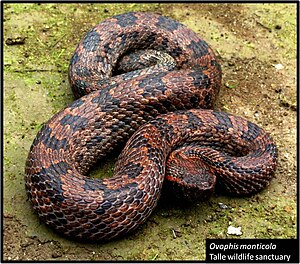Mountain pit viper
| Mountain pit viper | ||||||||||||
|---|---|---|---|---|---|---|---|---|---|---|---|---|

Mountain pit viper ( Ovophis monticola ) |
||||||||||||
| Systematics | ||||||||||||
|
||||||||||||
| Scientific name | ||||||||||||
| Ovophis monticola | ||||||||||||
| ( Günther , 1864) |
The mountain pit viper ( Ovophis monticola ), also known as mountain Lanzenotter called, is an Asian snake species of vipers and pit vipers of the genus Ovophis .
The genus Cerrophidion , also known in German as mountain pit vipers, comes from America.
features
The mountain pit viper has a stocky build and reaches a total length of around 90 cm. When viewed from above, the head is triangular in shape and clearly stands out from the neck. The eye is relatively small and has a pupil that is vertically slit when exposed to light. The body has a light brown basic color. Dorsally there are a number of dark brown spots that are irregularly arranged and partly connected to one another. The flanks are marked by smaller spots. A light-colored band runs between the snout and the corner of the mouth and runs through the eye. The ventral side is whitish to gray in color and speckled brownish. The tail is dark brown on top.
As is typical for vipers, the venom apparatus consists of venom glands located on the side of the skull (specialized salivary glands) and movable fangs located in the anterior upper jaw (solenoglyph tooth position).
Pholidosis
The pholidosis (scaling) shows the following characteristics:
- on top of the head small shields, which can be keeled or smooth,
- 8 to 9 shields of the upper lip ( Scuta supralabialia ),
- 23 to 25, rarely 27 rows of back scales ( scuta dorsalia ), which can be smooth or slightly keeled,
- 132 to 158 abdominal shields ( scuta ventralia ),
- 21 to 57 under- tail shields ( Scuta subcaudalia ) and
- 1 undivided anal shield ( scutum anale ).
Taxonomy
The first description under the name Trimeresurus monticola was made by the German-British zoologist Albert Günther in 1864. The most important synonyms are:
- Trimeresurus monticola Günther 1864
- Lachesis monticola Venning 1910
- Trimeresurus monticola monticola Mell 1929
- Trimeresurus monticola meridionalis Bourret 1935
- Ovophis monticola meridionalis Hoge & Romano-Hoge 1981
The taxonomic status of the genus Ovophis is unclear, molecular biological studies by Tu et al. (2000) did not support the genus.
Subspecies
The information on the subspecies of Ovophis monticola vary depending on the author. The following subspecies have been described:
- Ovophis monticola monticola
- Ovophis monticola convictus - largely recognized as an independent species
- Ovophis monticola makazayazaya
- Ovophis monticola orientalis
- Ovophis monticola zhaokentangi
O. monticola makazayazaya and O. monticola orientalis are considered synonymous with each other by some authors, and in some cases they are given species status under the name Ovophis makazayazaya . Another subspecies, O. monticola zayuensis , is also sometimes listed as a separate species.
distribution
The distribution area of the species includes areas in Bangladesh , Bhutan , Cambodia , China (including Tibet and Hong Kong ), Indonesia , India , Laos , Malaysia , Myanmar , Nepal , Taiwan , Thailand and Vietnam . The populated habitats are located at altitudes between 1,000 and 2,600 m above sea level and are represented by mountain slopes and scree slopes with grass and bamboo vegetation. Furthermore occurs Ovophis monticola as Kulturfolger in appearance and can be used in tea plantations, masonry, gardens and even houses are found occasionally.
Way of life
Ovophis monticola leads a ground-dwelling and largely nocturnal way of life. The prey spectrum of the snake primarily includes small mammals such as rats and mice as well as lizards. The propagation is done by oviparity so oviparous. The clutch consists of 6 to 18 eggs sticking together and is deposited in a hole in the ground, another depression in the ground or under rotting plant material. The eggs measure 26 to 40 mm in length and 23 to 24 mm in width. The hatching takes place in September, the young snakes are about 18 to 20 cm long when they hatch.
Ovophis monticola is not particularly aggressive. When provoked, the body is curled up and the tip of the tail trembles, which, for example, makes a dry leaf rattle. When approaching, the snake defends itself by biting.
Snake venom
The poison secretion of Ovophis monticola contains substances that influence hemostasis (pro and anticoagulants) and hemorrhagins ( metalloproteases ). A poison bite is usually mild in humans, although a lethal course cannot be ruled out. In addition to non-specific general symptoms (e.g. headache, dizziness, nausea, vomiting), local pain and edema , blistering , necrosis , coagulopathy , haemorrhages and shock can occur. Various antivenins are available for the treatment of severe intoxication , for example 'Polyvalent Anti Snake Venom Serum' (Central Research Institute, India).
etymology
The specific epithet "monticola" comes from the Latin and means "inhabitant of the mountains" (according to "colere" - "inhabitant"; "montis" - "mountain").
Individual evidence
- ↑ a b The Reptile Database: Ovophis monticola (accessed April 26, 2019)
- ↑ a b University of Adelaide, Clinical Toxinology Resources: Ovophis monticola (accessed April 13, 2019)
literature
- Ludwig Trutnau: Snakes in the Terrarium Vol. 2: Poisonous snakes . Verlag Ulmer, Stuttgart 1998, ISBN 3-800-1705-23 .